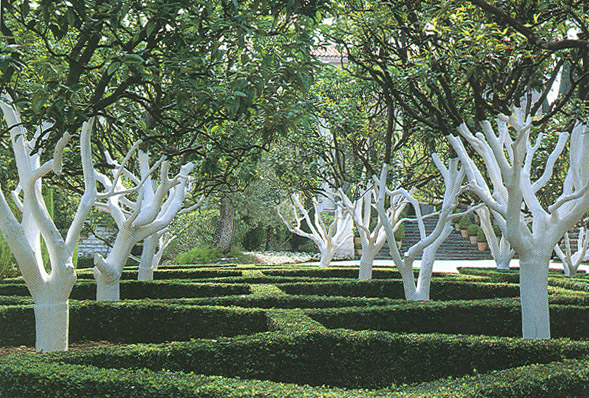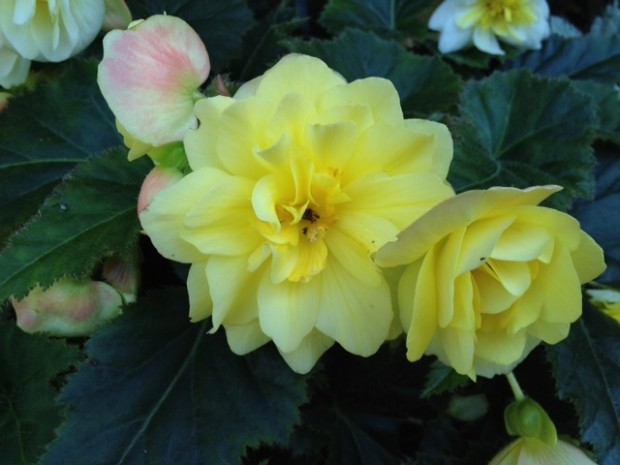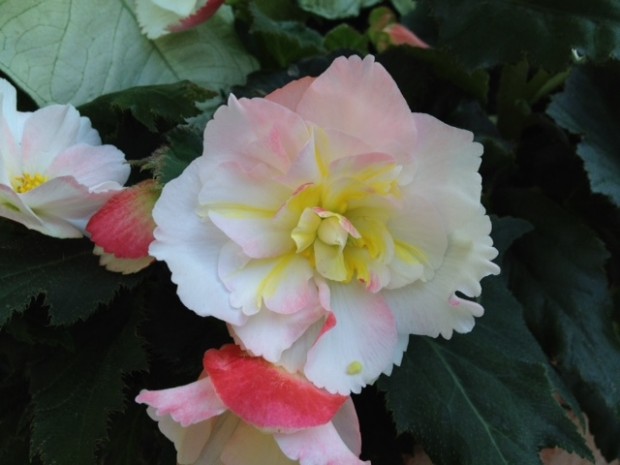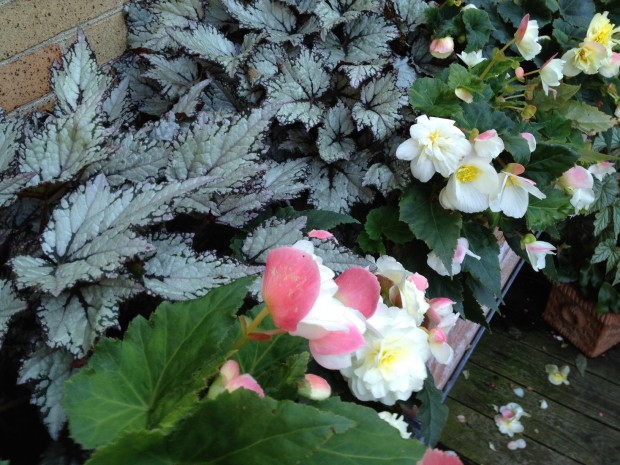
I cut this picture out of a magazine years ago-would that I could say I had designed this. White washing tree trunks has its roots in agriculture. Lime wash was used to prevent sunscald on ornamental and fruit trees. Grape vines were frequently lime washed to discourage fungal problems and pests. Kaolin, a type of clay used as a base for face powder, would be sprayed on the trunks and undersides of the leaves of fruit trees, though this has proved largely ineffective against insects and disease. Agriculture aside, the painting of these tree trunks set in a pattern of boxwood is visually arresting-bold.

I workede for a landscape designer in the 1980’s-Al Goldner. He once told told me his one regret regarding his career was that he had not been bold enough. As in bold design. Bold textures. Bold color. Bold curves. Confident moves. Bold thinking. I remember this about him more than anything else-his committment to visually striking design.
Boldly textured leaves make an emphatic statement. The calocasia leaves holding forth over the skinny legs of this antique faux bois planter-the invention of my client. She has an instinct for boldly textured and dramatic containers. Black calocasia and phormium are plants perfectly capable of a bold visual delivery. There is nothing subtle about them but for the color. This planting is about bold forms and relationships.
Espaliered trees are a form of growing and pruning that I greatly admire. What is so bold about these American hornbeams was the idea to bend the leader over at the pergola roof line. I am sure this shape was established at a very early stage in the lives of these trees. A bold vision of what would be many years later drove this planting. By this time the trees probably have no need of the pergola for support and guidance. One could imagine that the pergola could be removed, and the shape represented entirely by the trees.
This garden calendar is bold all right. The size is competely unexpected. Ordinary plants in unexpectedly small or large sizes attract interest. An overscaled element in a garden properly done can be a bold gesture. A single big idea makes a bigger impact than many little ideas clamouring for attention.
Amaranthus is bold in both form and color. Small intimate spaces can suddenly acquire a romantic atmosphere with one rose in a small vase. Big spaces may need bold gestures to create an atmosphere. A single rose in a large room with many people will seem lukewarm and lackluster. A big part of making a bold statement in a landscape is getting the scale right.

This green man medallion hand cast by Phillip Thomason on one of his modern coadestone boxes is a sculptural marvel. Phillip Thomason may be is premier pot maker of the 21st century. His works rarely come to market. His commissions are many-get in the queue. This hand made box could easily organize an entire landscape. The face is boldly modelled; the features are distinct, even from a distance.
This 1950 Dodge Coronet woodie is as bold as can be. The shape, the abundance of chrome, the color, size and the styling-all bold. It looks big enough to hold enough to hold a decent sized event. Heavy and strong enough to protect its occupants. Automotive designers are not just concerned with safety and efficiency, but great style. This vintage station wagon-a sculpture on wheels.
This rare and massive cast iron tank would be a bold addition to a landscape. It has battleship like proportions, but very graceful lines. It would come with a very bold price-much more than the original price of the Dodge Coronet pictured above. Luckily bold design has almost nothing to do with price. Everyone has seen landscapes that look like they cost a lot of money and have little to show for it. Will I buy the iron tank? I am thinking about.
It was a bold urban planner who made the decision to line this street not far from me with London planes. What a welcome relief they are from the standard Norway or silver maples. They seem incredibly healthy, given that these giant trees are constrained on both sides by cement. The maples in my neighborhood all show signs of stress from girdling roots, not to mention the sidewalk sections that are lifted off grade by their roots. I would not have thought London planes would make great street trees, but this bold move seems to be working.
There are plenty of choices, should bold flowers appeal to you. Dahlias-the showgirls of the flower world. In that same vein, add in hardy hibiscus, delphiniums, bearded iris, giant alliums and oriental lilies. Bold flowers planted as hedges-very bold. Someday I will have an opportunity to plant a long thick hedge of hardy hibiscus.
Topiary evergreens have bold shapes. This simple planting in a lead box, set in a paving arrangement scaled to celebrate that box may not be moving or romantic, but it certainly is handsome.

This pair of white glazed French pots make a spectacularly bold and elegantly formal statement. All of those cut delphiniums in one place took my breath away. There was no need for any other flowers.
All of these vintage dolly tubs lined up on a terrace with i gallon size chartreuse dawn redwoods, or tomatoes, or dwarf horsetails in them-every bit as bold as as that embarassment of riches in delphinium. Bold is as bold does.





























